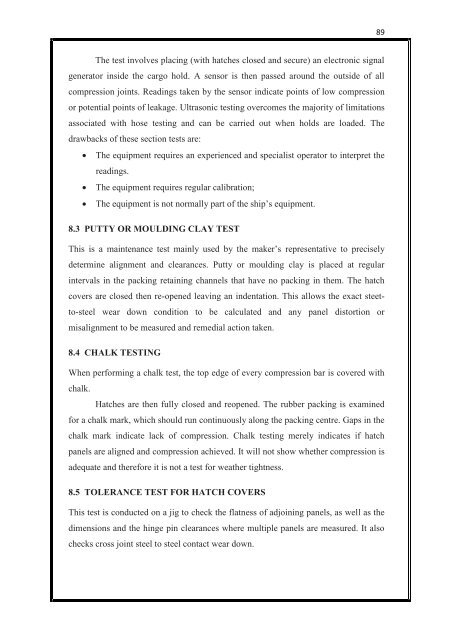Single pull macgregor type hatch cover.pdf - Cochin University of ...
Single pull macgregor type hatch cover.pdf - Cochin University of ...
Single pull macgregor type hatch cover.pdf - Cochin University of ...
Create successful ePaper yourself
Turn your PDF publications into a flip-book with our unique Google optimized e-Paper software.
The test involves placing (with <strong>hatch</strong>es closed and secure) an electronic signal<br />
generator inside the cargo hold. A sensor is then passed around the outside <strong>of</strong> all<br />
compression joints. Readings taken by the sensor indicate points <strong>of</strong> low compression<br />
or potential points <strong>of</strong> leakage. Ultrasonic testing overcomes the majority <strong>of</strong> limitations<br />
associated with hose testing and can be carried out when holds are loaded. The<br />
drawbacks <strong>of</strong> these section tests are:<br />
� The equipment requires an experienced and specialist operator to interpret the<br />
readings.<br />
� The equipment requires regular calibration;<br />
� The equipment is not normally part <strong>of</strong> the ship’s equipment.<br />
8.3 PUTTY OR MOULDING CLAY TEST<br />
This is a maintenance test mainly used by the maker’s representative to precisely<br />
determine alignment and clearances. Putty or moulding clay is placed at regular<br />
intervals in the packing retaining channels that have no packing in them. The <strong>hatch</strong><br />
<strong>cover</strong>s are closed then re-opened leaving an indentation. This allows the exact steet-<br />
to-steel wear down condition to be calculated and any panel distortion or<br />
misalignment to be measured and remedial action taken.<br />
8.4 CHALK TESTING<br />
When performing a chalk test, the top edge <strong>of</strong> every compression bar is <strong>cover</strong>ed with<br />
chalk.<br />
Hatches are then fully closed and reopened. The rubber packing is examined<br />
for a chalk mark, which should run continuously along the packing centre. Gaps in the<br />
chalk mark indicate lack <strong>of</strong> compression. Chalk testing merely indicates if <strong>hatch</strong><br />
panels are aligned and compression achieved. It will not show whether compression is<br />
adequate and therefore it is not a test for weather tightness.<br />
8.5 TOLERANCE TEST FOR HATCH COVERS<br />
This test is conducted on a jig to check the flatness <strong>of</strong> adjoining panels, as well as the<br />
dimensions and the hinge pin clearances where multiple panels are measured. It also<br />
checks cross joint steel to steel contact wear down.<br />
89

















